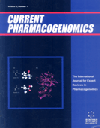- Home
- A-Z Publications
- Current Pharmacogenomics
- Issue Home
Current Pharmacogenomics - Current Issue
Volume 5, Issue 4, 2007
-
-
Renin--Angiotensin System Gene Polymorphism and Regression of Left Ventricular Hypertrophy in Hypertension
More LessAuthors: E. V. Shlyakhto and A. O. ConradyEvidence is beginning to accumulate that not only development and progression of left ventricular hypertrophy (LVH) in hypertension is genetically predisposed, but its regression during therapy has several genetic determinants. Renin-angiotensin system (RAS) is generally considered to be the major contributor to LVH development. I/D polymorphism of angiotensin-converting enzyme (ACE) gene was shown to determine plasma Read More
-
-
-
Prognostic and Predictive Markers in Colorectal Cancer - The Role of New Genomic Technologies
More LessAuthors: Vicky M. Coyle, Wendy L. Allen, Daniel B. Longley and Patrick G. JohnstonColorectal cancer (CRC) is one of the most frequently occurring malignancies worldwide, and the second leading cause of cancer related death in the Western World. Although early stage disease is curable by surgical resection alone, one half of patients with CRC will present with metastatic disease at some stage in the course of their disease. The most active drug in the treatment of CRC is 5-fluorouracil (5-FU) which is used i Read More
-
-
-
Genetic Polymorphisms of Human Sulfate Transporters
More LessAuthors: Paul A. Dawson and Daniel MarkovichSulfate (SO4 2-) is an abundant nutrient in the blood and is essential for normal growth and development. SO4 2- is conjugated (sulfonated) to many compounds in the body, including glycosaminoglycans, steroid hormones and bile acids. Sulfonation also plays an important role in the metabolism of xenobiotics and certain drugs, such as acetaminophen. SO4 2- enters and exits cells via plasma membrane SO4 2- transp Read More
-
-
-
Tumour Necrosis Factor α Gene Promoter and its Role in Rheumatoid Arthritis Outcome and Pharmacogenetics
More LessAuthors: Joao E. Fonseca, Jose Teles and Mario Viana QueirozRheumatoid arthritis (RA) is a chronic inflammatory disease which affects approximately 1% of the world population. A considerable effort has been put into understanding the genetic factors associated with this complex disease. Sequencing of the human genome has opened new prospects for the detection of genetic variants associated with increased susceptibility, poor prognosis and inadequate response to therapy. One of th Read More
-
-
-
Should the Status of the Pathway Mediated by BRCA1 and BRCA2 be Evaluated Before Selecting Cancer Chemotherapy Drugs?
More LessThis review brings together evidence to show that chemotherapy agents that cause DNA double strand breaks have increased success in treating model cancers with deficits in the pathway containing BRCA1/2 proteins. In people who do not have BRCA1 or BRCA2 gene mutations, the encoded proteins prevent breast/ovarian cancer. However BRCA1 and BRCA2 proteins have multiple functions including participating in a pathway Read More
-
-
-
The Flavin-Containing Monoooxygenases (FMOs): Genetic Variation and its Consequences for the Metabolism of Therapeutic Drugs
More LessAuthors: Ian R. Phillips, Asvi A. Francois and Elizabeth A. ShephardFlavin-containing monoooxygenases (FMOs) are a family of enzymes involved in the metabolism of foreign chemicals, including many therapeutic drugs. In this review we focus on the functional FMOs of humans (FMOs 1, 2, 3, 4 and 5). For each FMO we describe its gene organization, developmental- and tissue-specific pattern of expression, substrate specificity and the identity, frequency and functional effect of polym Read More
-
-
-
Connexin Genes as Promising Therapeutic Targets in Cancers
More LessAuthors: Tomohiro Yano, Hiromi Sato, Hiromi Hagiwara and Nantiga VirgonaCellular homeostasis in many organs is maintained via gap junctions composed of connexin (Cx), a large protein family with a number of subtypes. In fact, gap junctional intercellular communication (GJIC) is actively involved in all aspects of the cellular life cycle, ranging from cell growth to cell death. It has been well known that Cx genes act as tumor suppressor genes in GJIC-dependent and GJIC-independent manners. Actually, Read More
-
Most Read This Month Most Read RSS feed
Article
content/journals/cpg
Journal
10
5
false
en


